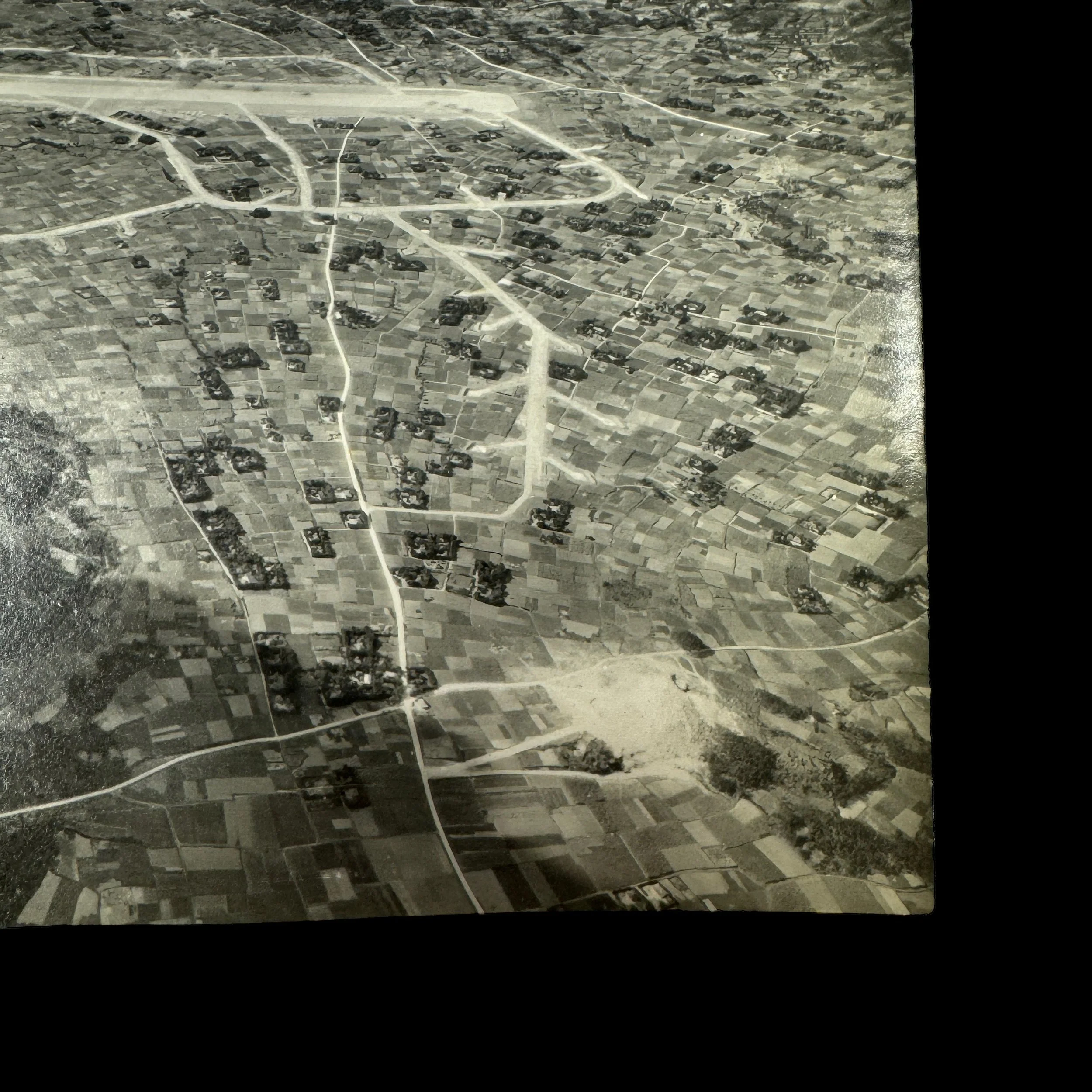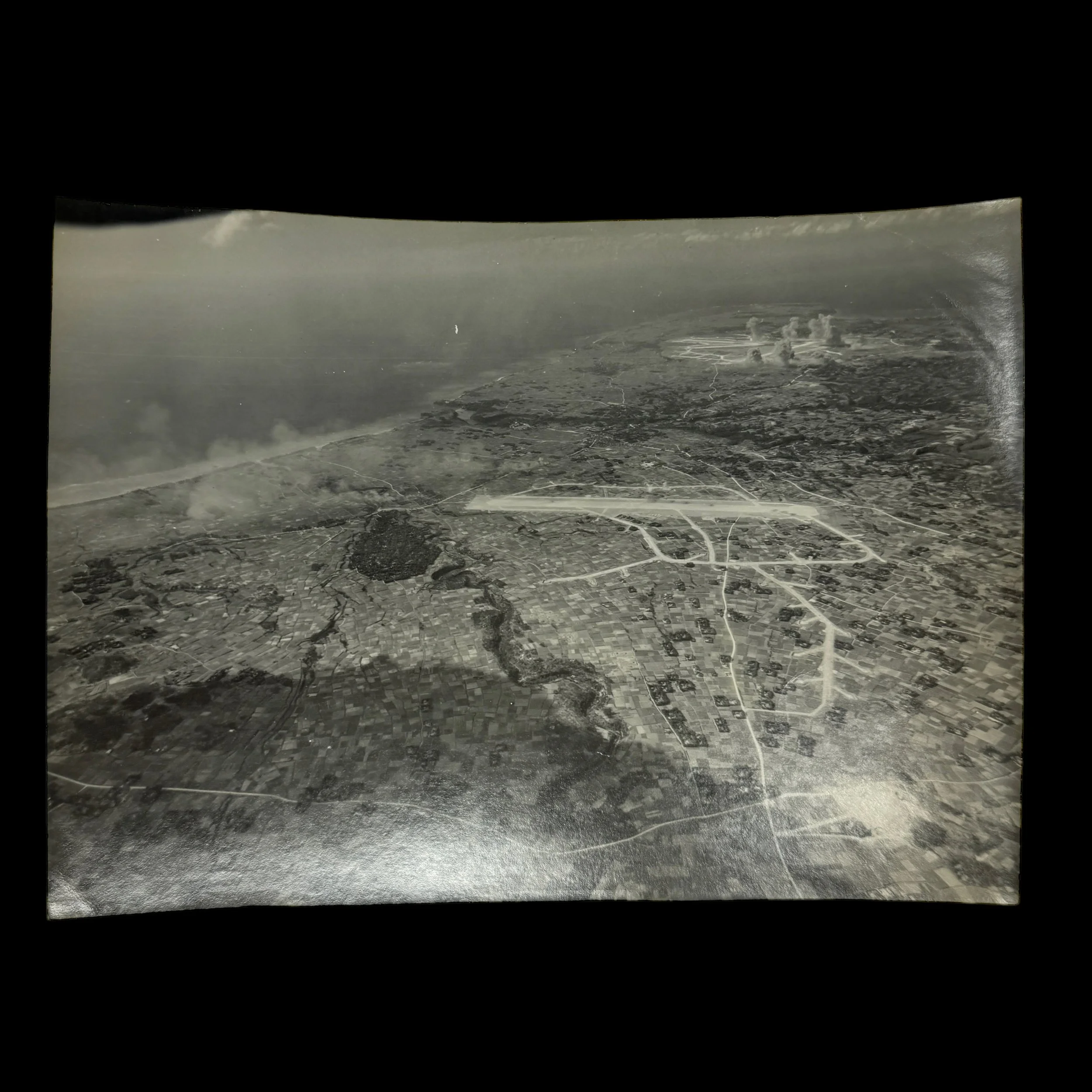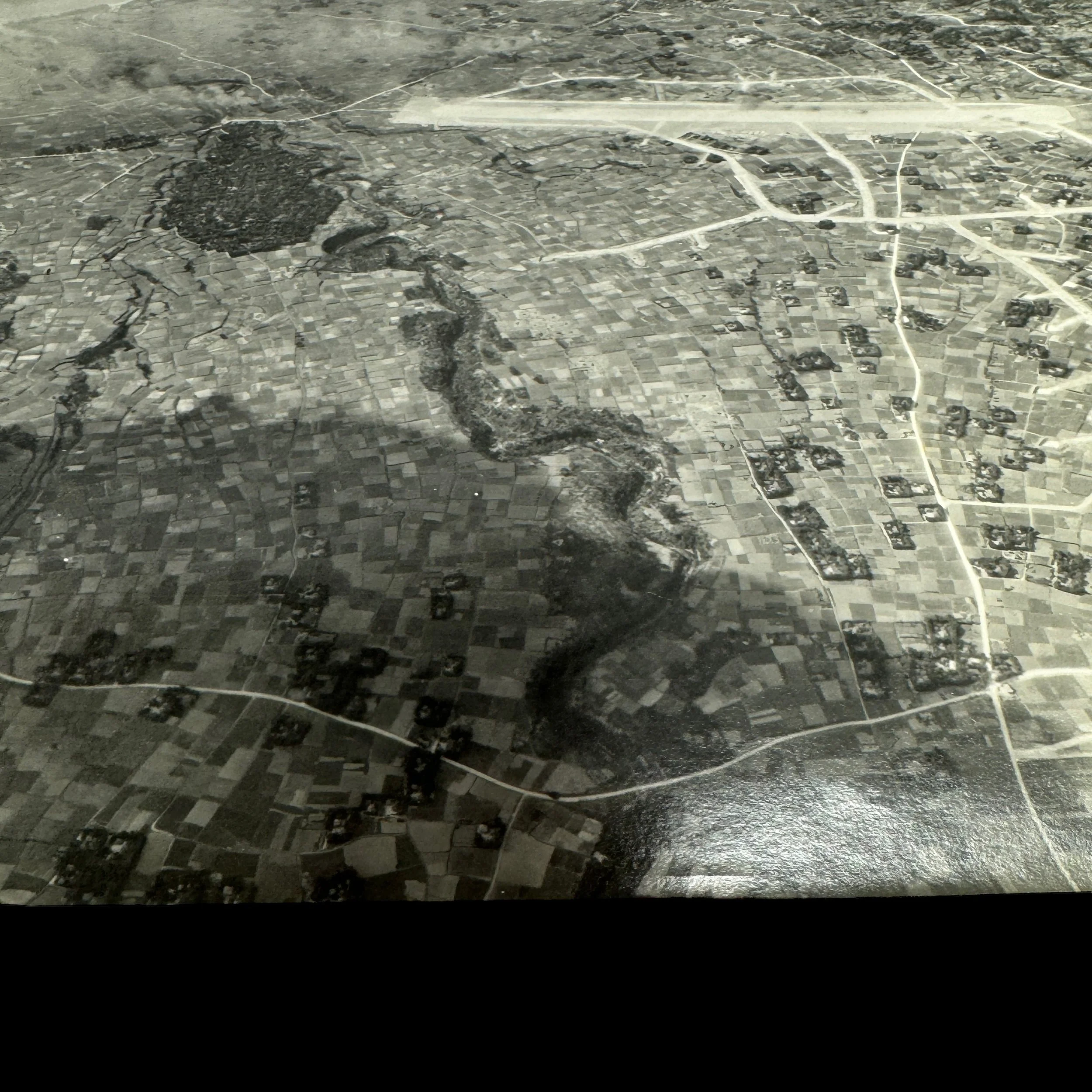RARE! WWII JAPANESE AIRFIELDS Vice Admiral Mitscher Fast Carrier Task Force 1944 Okinawa Mission "RESTRICTED" Aerial Reconnaissance Type-One (FIRST PRINT) Photograph*


















RARE! WWII JAPANESE AIRFIELDS Vice Admiral Mitscher Fast Carrier Task Force 1944 Okinawa Mission "RESTRICTED" Aerial Reconnaissance Type-One (FIRST PRINT) Photograph*
Comes with C.O.A.
*FROM A LARGE BRING-BACK COLLECTION OF TYPE-ONE AERIAL RECON PHOTOGRAPHS FROM THE USS FRANKLIN - USS INTREPID - & USS WASP.
This extremely rare and museum-grade World War II type-one Okinawa aerial reconnaissance photograph was taken by Vice Admiral Mitscher’s TASK FORCE 38 & TASK FORCE 58 aircraft carrier aerial squadrons during the first U.S. Fast Carrier Task Force strike on Okinawa during WWII.
Vice Admiral Mitscher launched an early strike on Okinawa on October 10th, 1944. His fast carrier force launched waves of planes from nine U.S. aircraft carriers, dropping 541 tonnes of bombs, and firing 652 rockets and 21 torpedoes. The capital Naha was left aflame, 111 enemy aircraft were destroyed, and – according to Japanese estimates – five million rounds of Japanese machine-gun ammunition were ruined.
This aerial photograph obtained from the October 1944 raid on Okinawa allowed the U.S. pilots to gain aerial reconnaissance of more than 90% of the island of Okinawa. These original TYPE-ONE aerial reconnaissance photographs were used to create the infamous Operation Iceberg - Invasion of Okinawa target maps that were prepared by American intelligence for the D-Day invasion on April 1st, 1944.
The map, scale 1 : 25,000, was based on aerial photographs obtained on 29 September and 10 October 1944 and was distributed about 1 March 1945. Incomplete coverage, varying altitudes of the planes, and cloudiness over parts of the island at the time prevented clear delineation, and certain portions of the map, including that of the high ground north of Shuri, had either poor topographic detail or none at all. Additional photographic coverage of the island was obtained on 3 and 22 January, 28 February, and 1 March 1945; that of 22 January was excellent for the proposed landing beach areas. To supplement aerial photography a submarine was sent from Pearl Harbor to take pictures of all Okinawa beaches. The submarine never returned.
During WWII, the U.S. Task Force 38 and Task Force 58, spearheaded the thrust against the heart of the Japanese Empire, covering successively the invasion of the Palaus, the liberation of the Philippines, and the conquests of Iwo Jima and Okinawa.
FULL HISTORY OF FAST CARRIER TASK FORCE DURING WWII:
During World War II, naval operations in the Pacific Theater marked a significant evolution in naval warfare, largely defined by the prominent role of aircraft carriers. The Fast Carrier Task Forces 58 and 38, operating interchangeably under the command of Admirals Marc Mitscher and John S. McCain, Sr., respectively, were central to this transformative period. These task forces, shifting designations with the change of operational command between the U.S. Third and Fifth Fleets, played crucial roles in the success of the United States Navy against Imperial Japanese forces from 1944 to 1945.
Formation and Structure
The origin of Fast Carrier Task Force 58 (part of the Fifth Fleet under Admiral Raymond Spruance) and Task Force 38 (part of the Third Fleet under Admiral William Halsey) can be traced back to earlier carrier task forces in 1943. However, it was in 1944 that these forces were expanded and reorganized to harness the full offensive potential of the newest Essex-class aircraft carriers, along with a supporting fleet of battleships, cruisers, and destroyers. The dual-numbering system (58/38) reflected a strategic decision to maintain continuous operational pressure on Japanese forces while allowing for logistical flexibility and maintenance cycles.
Strategic and Tactical Employment
The strategic use of these task forces was revolutionary. Prior to the establishment of TF 58 and TF 38, carriers were typically used in a more conservative manner, often in support of battleship operations. However, Mitscher and his successors envisioned the carriers as the primary striking arm of the fleet, capable of projecting power over vast distances with unprecedented speed and force.
The tactical doctrine developed around these task forces emphasized agility, surprise, and overwhelming force. Through a combination of high-speed maneuvers and concentrated air power, they were able to strike targets across the breadth of the Pacific, ranging from the Gilbert and Marshall Islands to the heart of the Japanese home islands. Carrier-based aircraft were used not only to gain air superiority but also to conduct bombing raids, support ground operations, and cut off Japanese supply lines.
Major Operations and Impact
Operation Hailstone
One of the first demonstrations of TF 58's might came with Operation Hailstone in February 1944. The attack on the Japanese naval base at Truk Lagoon marked a significant turning point; it effectively neutralized one of Japan's most formidable forward-operating bases through continuous carrier-based air strikes. This operation showcased the task force's ability to deliver devastating blows against enemy strongholds, significantly impairing Japanese naval capabilities.
Philippine Sea
Perhaps the most definitive battle involving TF 58 was the Battle of the Philippine Sea, often referred to as the "Great Marianas Turkey Shoot" due to the lopsided losses inflicted on Japanese air forces. This battle not only decimated Japanese aerial combat strength but also underscored the effectiveness of American carrier air power and anti-aircraft capabilities.
Leyte Gulf
During the Battle of Leyte Gulf, the largest naval battle of World War II, TF 38 played a critical role in defending the amphibious landings in the Philippines and in ultimately crippling the remaining Japanese surface fleet. This operation demonstrated strategic flexibility as American forces adapted to complex battle conditions and enemy tactics.
Iwo Jima and Okinawa
Throughout the campaigns of Iwo Jima and Okinawa, the task forces provided essential air cover and direct support to ground forces, showcasing the indispensable role of carrier-based aircraft in amphibious operations and direct ground support.
Legacy
The operational success of Fast Carrier Task Forces 58 and 38 had profound implications for naval warfare, firmly establishing the aircraft carrier as the dominant naval platform in the post-war era. Their effectiveness influenced post-war naval strategy and the development of carrier tactics and technology.
The historical significance of Fast Carrier Task Forces 58 and 38 cannot be overstated. They not only played pivotal roles in the Pacific Theater during World War II but also set the stage for modern naval operations. Through innovative tactics, strategic foresight, and relentless execution, they demonstrated the aircraft carrier's capability to project power and achieve naval supremacy, fundamentally reshaping naval warfare in the 20th century and beyond.